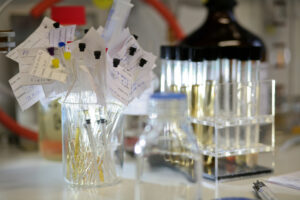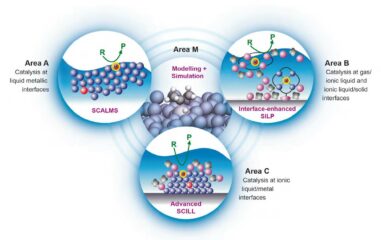Research
This CRC, Catalysis at Liquid Interfaces (CLINT), will follow a new paradigm: We aim to explore the highly dynamic, anisotropic environment of liquid interfaces to create, tailor and stabilise catalytically active sites with unique reactivity and performance. With this concept, we aim to develop novel catalytic materials that combine selectivity, productivity, robustness, and ease of processing at the highest level. CLINT consists of four strongly interlinked research areas (A, B, C, and M). All approaches centre on solid-supported liquids of ultralow vapour pressure to enable stable catalytic performance in continuous gas-phase reactions.

Area A ‘SCALMS’ deals with the dynamic formation of supported liquid alloy interfaces in the presence of reactive gases, representing a new, technically relevant route toward heterogeneous single-atom catalysts. The concept of ‘Supported Catalytically Active Liquid Metal Solutions (SCALMS)’, established recently by four PIs jointly, will be explored systematically towards optimised materials properties and enhanced performance. We aim to develop SCALMS into a fundamentally understood and scalable approach for new catalytic materials with highest reactivity, metal efficiency and ultimate robustness.
Area B ‘Interface-enhanced SILP’ focusses on dissolved molecular catalyst complexes that show a very high preference to be located at the interfaces of ‘Supported Ionic Liquid Phase (SILP)’ systems. The interface affinity should be a function of the applied ligands, support chemistry, ionic liquid, and gas phase. Our research target is to elucidate and exploit the specific reactivity located at both, the gas/liquid and the liquid/solid interface.
Area C ‘Advanced SCILL’ deals with dynamic interactions at the reactive interfaces between ionic liquids and catalytically active metals. We aim to radically expand the powerful approach of ‘Solid Catalysts with Ionic Liquid Layer (SCILL)’ for the manipulation of traditional supported catalysts by using novel functionalised ILs and by applying the concept to novel (electro)catalytic transformations.
The areas A, B, and C are tightly interlinked by the overarching research aspects of wetting, selective molecular interaction or adsorption, diffusion and mobility, segregation and enrichment, ligand and ensemble effects, and the anisotropy of reactive environments at the interface. To bridge between a detailed understanding of these aspects and the development of new catalyst materials, each area will link fundamental studies on model systems with kinetic investigations using real catalysts. Area M ‘Modelling and simulation’ addresses these joint aspects by theoretical studies elucidating, e.g. the electronic structure of complex liquid interfaces, the distributions of active sites, or the dynamics of self-organisation and structure formation at the interface. In this way, we will seek to develop a comprehensive approach to the new concept of catalysis at liquid interfaces.



